
Winning Strategies: More Than Just Horsepower
The Cal Poly tractor pull is a captivating blend of raw power and meticulous engineering. While sheer horsepower is undeniably important, victory hinges on a sophisticated understanding of several key factors. Think of it like a chess match – brute force alone won't win; strategic planning and precise execution are crucial. How do teams balance raw power with efficient weight distribution to maximize traction without sacrificing speed? This requires a deep understanding of physics and engineering principles. For more information on tractor pulls, check out this helpful resource.
What engineering challenges do teams overcome to create a winning tractor?
One crucial aspect is weight distribution. A winning tractor needs sufficient weight for optimal traction, but excessive weight can impede speed and maneuverability. Finding this "sweet spot" is a significant challenge. Another major consideration is the tractor's design itself, including aerodynamics – yes, even in a dirt-based competition, aerodynamics plays a surprising role in reducing drag and improving overall performance.
Dr. Emily Carter, Professor of Mechanical Engineering, Cal Poly: "The Cal Poly tractor pull is a phenomenal demonstration of applied engineering principles. Students learn to integrate theory with practice, facing real-world constraints and developing practical solutions."
Engineering Innovation: Pushing the Boundaries
The competition isn't just about building tractors; it's about pushing the boundaries of engineering innovation. Each year witnesses remarkable advancements, from lighter yet stronger materials thanks to breakthroughs in materials science, to improvements in power transmission systems that ensure maximum power transfer to the wheels. These innovative solutions are the result of countless hours of hard work and a relentless pursuit of excellence.
What innovative solutions have Cal Poly students implemented to enhance their tractors' performance?
Imagine the pressure: you have a limited budget, a strict timeline, and the weight of your team's reputation riding on your shoulders. This crucible of pressure forges exceptional problem-solving skills. The constant striving for improvement is what makes the Cal Poly tractor pull so captivating. Students aren’t just building machines; they're shaping their futures.
Mr. David Lee, Team Captain, Cal Poly Tractor Pull Team “Muddy Mayhem”: "The innovation process is collaborative, and we learn immensely from each other's strengths. When we hit a snag, we brainstorm together, always finding a solution."
Decoding a Winning Tractor: A Deep Dive into Key Components
To understand the recipe for success, let's examine the critical components and strategies employed by the winning teams.
| Feature | Performance Impact | Innovative Strategies |
|---|---|---|
| Engine | The powerhouse; higher horsepower directly translates to greater pulling capacity. | Advanced turbocharging, optimized fuel injection systems, and innovative engine designs. |
| Transmission | Efficient power transfer from engine to wheels is paramount for maximizing pulling force. | Custom gear ratios tailored to the track, high-performance clutch systems, and advanced drivetrain designs. |
| Weight | The balance between traction and speed; sufficient weight for grip, but not so much as to hinder maneuverability. | Precise weight distribution, strategic use of lightweight yet strong materials, and refined chassis design. |
| Chassis | The structural backbone; must withstand immense forces while maintaining stability. | Reinforced frames, advanced suspension systems, and aerodynamic improvements to reduce drag. |
| Tires | The critical interface with the ground; optimal tire design is vital for maximum grip. | Specialized tread patterns calibrated to track conditions, and optimized tire pressure. |
Beyond the Competition: A Transformative Experience
The Cal Poly tractor pull is more than just a competition; it's a transformative experience for participating students. It fosters valuable skills beyond engineering, shaping them into well-rounded professionals. How does this competition contribute to personal and professional development?
The collaborative nature of the project teaches teamwork, project management, and problem-solving under pressure – skills highly valued in any professional field. The camaraderie forged through shared effort in the workshop, navigating setbacks and celebrating successes, creates bonds that extend far beyond graduation. The Cal Poly tractor pull isn't just a competition; it’s a proving ground for future leaders and innovators. What better way to learn about real-world engineering challenges than to create and operate a high-powered machine under intense competitive pressure?